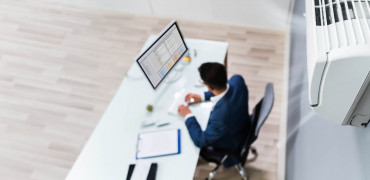Whether you are still remote working, embarking on a new hybrid working model, office-based once again, or still trying to decide what approach now suits you best, there is no denying that the last two years has seen a significant culture shift in our attitudes to our workplaces and work spaces.
One of the major impacts of the pandemic has been a greater recognition of the need to rethink office spaces, their functions and design to adapt to changing requirements.
The Chartered Management Institute has released research that shows 89% of UK organisations now offer flexible working arrangements, compared to just 58% prior to March 2020.
It also seems hybrid is here to stay, with a YouGov poll for Microsoft revealing that 51% of workers would consider leaving if mixed working was removed.
The success of switching to hybrid working will rely on a business’ ability to optimise productivity by making the transition from home to office a harmonious and welcoming one, with workspaces that recharge and reconnect people.
Offices should be somewhere people look forward to working in, enabling inspiration and emotional attachment
Different use of spaces
Existing buildings must be reimagined and reconfigured to provide a greater variety of spaces. Offices should be somewhere people look forward to working in, enabling inspiration and the emotional attachment that is lost through remote working.
Space is needed for team activities and collaboration alongside increased natural lighting, access to the outdoors, and environmental adjustability.
To achieve this, some are turning to more natural building materials, such as timber structures, biophilic design features to help evolve the concept of ‘office.’
For example, Paradise, near London’s Albert Embankment, a development by Bywater Properties, offers a ground floor that is open and inviting to anyone.
Designed by Feilden Clegg Bradley Studios, the 60,000 sq ft building will provide sustainable space for offices, research, makers, and artisans, while complementing the neighbouring Old Paradise Gardens.
This makes it a focal point for local businesses and residents, providing amenities, shared space, and human interaction.
Instinctive design
Creating spaces where people feel at ease requires design that recognises human instincts.
Increasing natural light and biophilic elements: views of nature and greenery, water, patterns that mimic nature, and indoor planting are simple yet effective methods. Another way is to use timber, leaving its natural grain exposed.
Another key feature of healthy buildings and a happy workforce is sustainability and cutting carbon.
In Clerkenwell, General Projects’ Technique development has regenerated an old gin distillery and bank headquarters to provide office and retail space with an extension made from CLT and glulam. This reduced carbon emissions by 43% compared to steel or concrete frames.
Targets for NABERS
New office developments are also being adjusted to focus on this changing nature of the workplace. The introduction of programmes such as the NABERS scheme is putting a firm focus on creating a new type of office environment.
NABERS, which stands for the National Australian Built Environment Rating System, has now moved to the UK as a product sold by BRE (Building Research Establishment).
Launched in November 2020, BRE say that NABERS UK aims to provide a simple, reliable system for rating the energy efficiency of office buildings across England, Wales, Scotland and Northern Ireland.
Quadrum has commenced construction on its sustainable office redevelopment at 11 Belgrave Road, London, which will be the first in the UK to achieve an Excellent 5.5-star NABERS design-reviewed target rating for building efficiency and one of only three to be pre-certified across the country.
Designed by Eric Parry Architects, the conversion of an existing commercial building will meet the highest sustainability and wellbeing credentials, taking its place as one of the capital’s most sustainable office buildings.
Ilyas Aslam, Chief Operating Officer at Quadrum, said: “Designing the redevelopment of 11 Belgrave Road has been an exciting opportunity to deliver a ground-breaking landmark office building for the next generation of occupier, focused on the highest ESG standards in an exceptional location and with wellbeing at its heart. By investing the time and effort to pre-certify its credentials, we can demonstrate real value rather than intention.
“The scheme combines beautiful architecture with exceptional occupier experience, providing the highest quality, flexible workspaces. Spacious terraces and the stand-out private garden provide areas for outdoor working, relaxation and events in an immersive, natural habitat to cultivate a healthy, productive place to work.”
Smart moves
Programmes such as NABERS - the only office-specific, in use, energy efficiency rating system - will see developers minimising carbon in operation and arming the building users with information and flexibility to aid this.
"Smart" mechanical ventilation with display screens to inform occupants of real-time information, carbon filters improve air quality for the building users and other initiatives and systems to ensure such spaces are fully future-proofed are becoming the norm.
Such moves are a natural progression as increasingly it is the building tenants who are dictating the changes they expect to see so that they can offer their workforce the type of office spaces they want to see and put the emphasis firmly on ensuring the health and wellbeing of their staff.
Paul Groves is editor of Specification magazine



